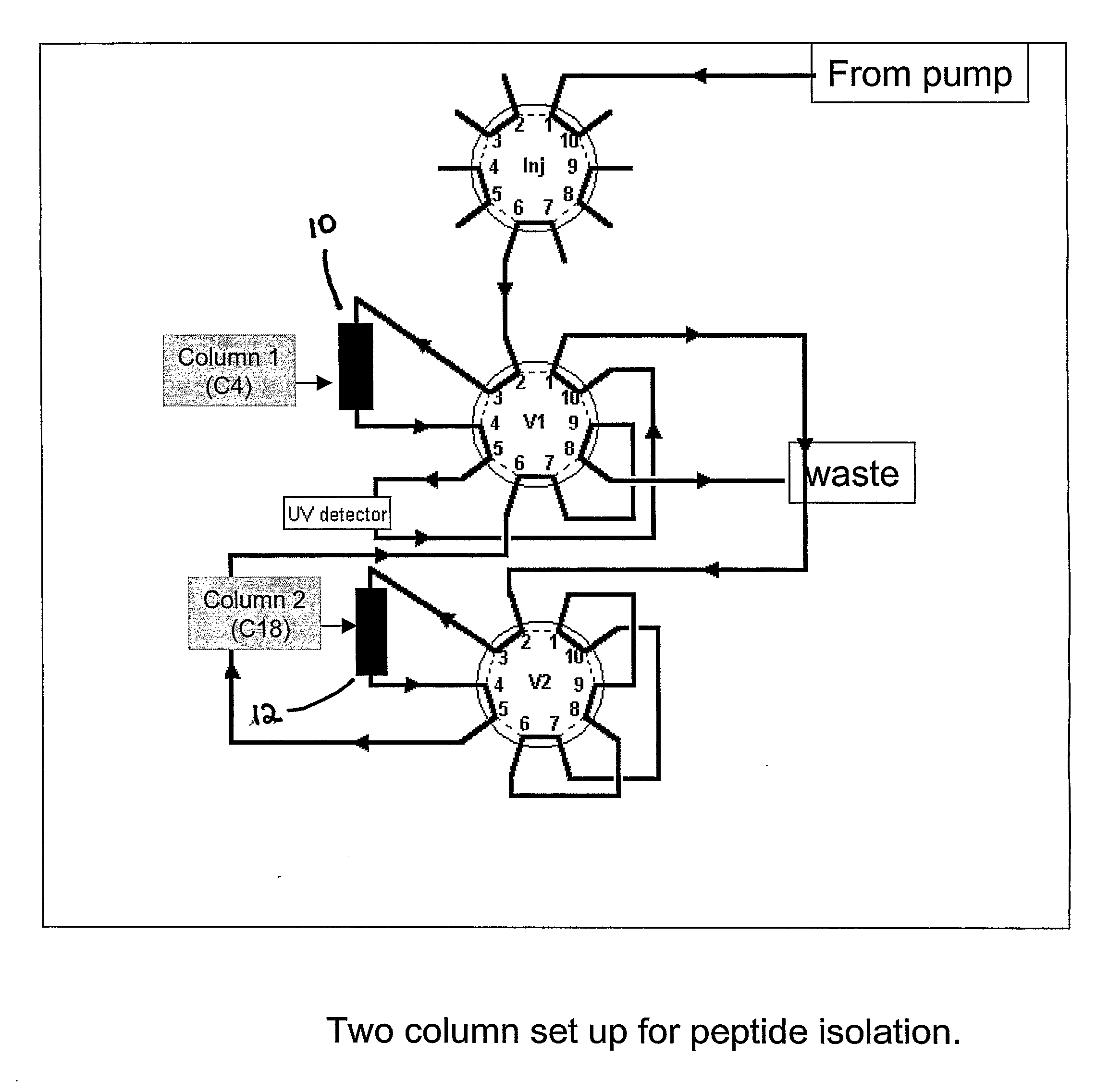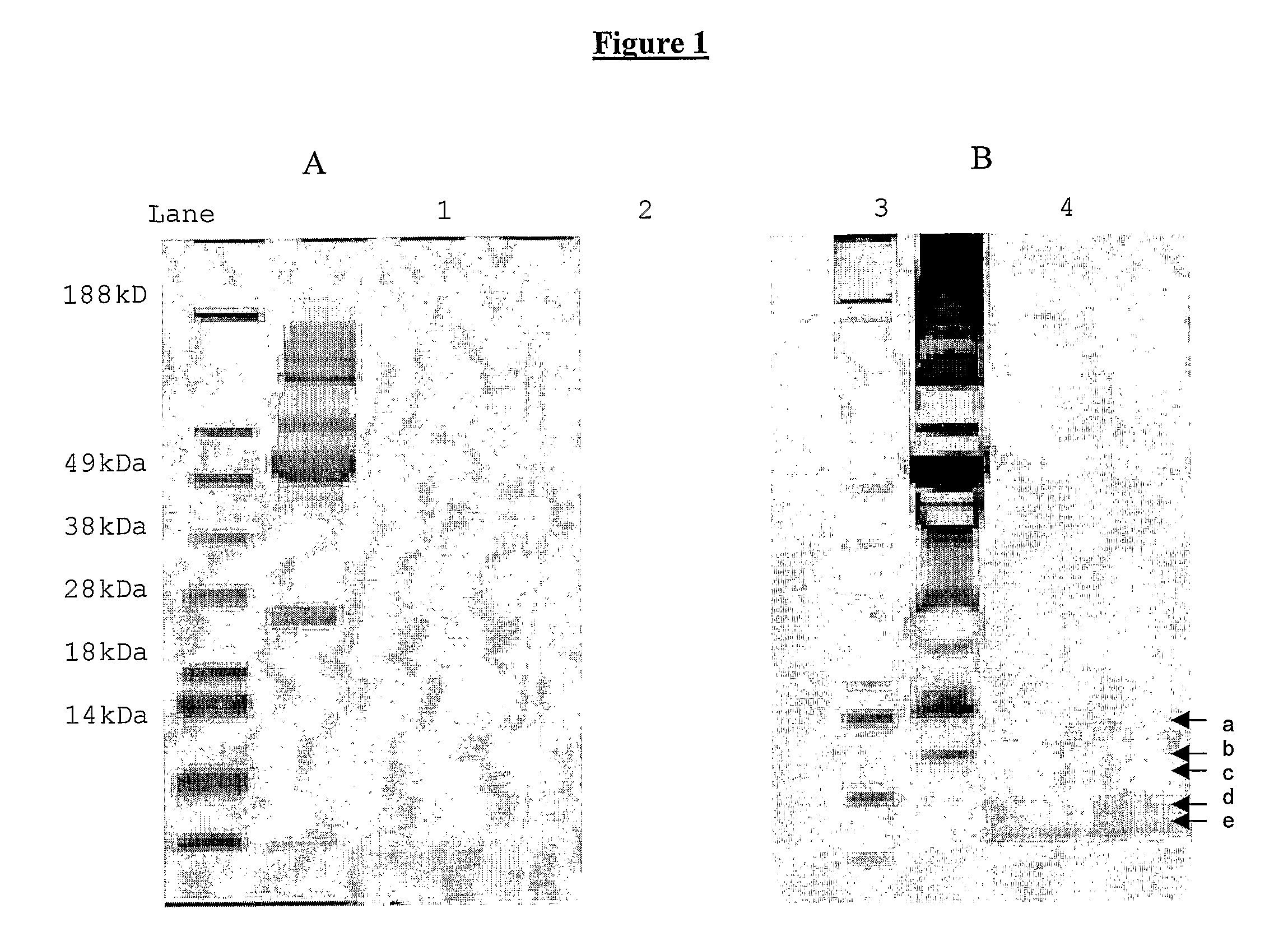Detection of Disease Associated Proteolysis
- Summary
- Abstract
- Description
- Claims
- Application Information
AI Technical Summary
Benefits of technology
Problems solved by technology
Method used
Image
Examples
example i
Analysis of the LMW Filtrate
[0051]Five hundred μL human serum was fractionated by ultrafiltration as described without being subjected first to enzymatic digestion, and the filtrate, depleted of high molecular weight (HMW) proteins, was collected. A commercial protein assay kit (BCA) was used to determine the protein concentrations of the starting material and the filtrate. The values were about 60,000 μg / mL and 190 μg / mL, respectively. A yield of ˜0.33 mg of the low molecular weight (LMW) fraction was obtained from ˜30 mg of proteinaceous material contained in a human serum sample (relative to a standard, bovine serum albumin). This amount of material represents approximately 1% of the initial protein mass and demonstrates the effectiveness of the ultrafiltration approach as a depletion method.
[0052]SDS PAGE analysis of the serum filtrate, concentrated either by cold acetonitrile precipitation or by use of a speed-vac, showed two weak bands in the low LMW region on the Coomassie® b...
example ii
NanoLC-MS / MS Analysis
[0054]The LC-MS / MS analysis of a serum filtrate was performed at least three times for each sample. To assess reproducibility, the average coefficient of variation (CV) of the retention time was measured for five different peptides, and the value was found to be 0.15% for three runs. A typical comparison of the resulting total ion chromatograms is shown in FIG. 2. Peptides were identified by MS / MS fragmentation in a hybrid linear ion trap-Fourier transform mass spectrometer (LTQ-FTMS) with conservative values for sequence assignment (Xcorr(1+, 2+, 3+)=1.80, 2.50, 3.50).9 To get higher confidence peptide identifications, the hybrid FT-ICR instrument was used to acquire accurate mass measurements (within 2 ppm) during the survey MS scan (see, e.g., PCT Appl. No. PCT / US05 / 30713, which is hereby incorporated by reference herein) . Therefore, in addition to high Xcorr criteria for the assignment of peptide sequence, high mass accuracy obtained in the FTMS was used as...
example iii
Observance of Peptide Laddering
[0058]Many identified peptides were derived from the same protein sequence, a phenomenon referred to here as peptide laddering. These ladders are the result of progressive N- and C-terminal amino acid cleavages. In total, 34 peptide ladders were observed, derived from 17 different serum proteins with cleavage at diverse residues such as lysine, proline and glycine (Tables 3 and 4, and FIG. 6).
TABLE 3No. of peptides inIDPeptide ladders identified in human serum.ladderFIBA aT.ADSGEGDFLAEGGGVR.G13R.GGSTSYGTGSETESPRNPSSAGSWNSGSSGPGSTGN33RNPGSSGTGGTATWKPGSSGPGPGSTGSWNSGSSGTGSTGNQNPGSPRPGSTGTWNPGSSE.RR.GSAGHWTSESSVSGSTGQWHSESGSFRPDSPGSGNA5.RR.REYHTEKLVTSKGDKEL.R4R.HPDEAAFFDTASTGKTFPGFFSP.M4L.GEFVSETESRGSESGIFTNTKESSSHHPGIAEFPSRG.K8K.SSSYSKQFTSSTSYNRGDSTFESKSYKMADEAGS34EADHEGTHSTKRGHA.KITH4 aR.MNFRPGVLSSRQLGLPGPPDVPDHAAYHPF.R30CO3 aR.SSKITHRIHWESASLLRSEETKENEGFTVTAEGK.G16CO4 aR.TLEIPGNSDPNMIPDGDFNSYVR.V4R.NGFKSHALQLNNRQIRGLEEELQFSLGSKINVKVG12GNSKGTLKVL.RK.DDP...
PUM
| Property | Measurement | Unit |
|---|---|---|
| Mass | aaaaa | aaaaa |
| Mass | aaaaa | aaaaa |
| Molecular weight | aaaaa | aaaaa |
Abstract
Description
Claims
Application Information
 Login to View More
Login to View More - R&D
- Intellectual Property
- Life Sciences
- Materials
- Tech Scout
- Unparalleled Data Quality
- Higher Quality Content
- 60% Fewer Hallucinations
Browse by: Latest US Patents, China's latest patents, Technical Efficacy Thesaurus, Application Domain, Technology Topic, Popular Technical Reports.
© 2025 PatSnap. All rights reserved.Legal|Privacy policy|Modern Slavery Act Transparency Statement|Sitemap|About US| Contact US: help@patsnap.com



